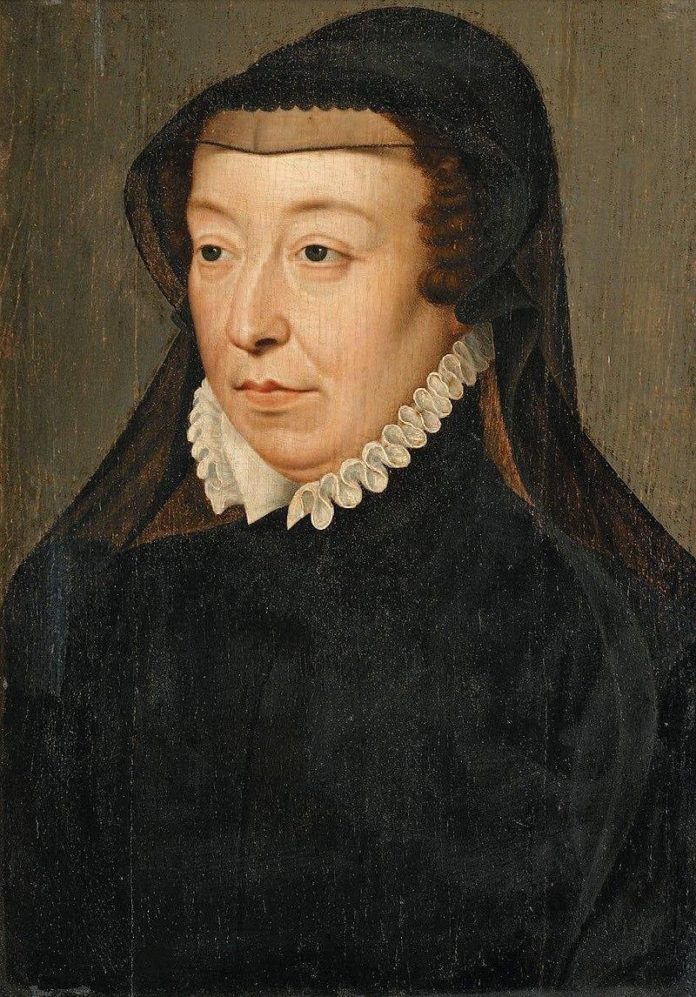
“Mountains do not rise without earthquakes”
- Katherine MacKenett
By Workshop of François Clouet – https://www.boisgirard-antonini.com/lot/9999/1842171, Public Domain, https://commons.wikimedia.org/w/index.php?curid=87745556
Chaos is what we make of it – a fire of destruction or a sea of opportunities. In the middle of the intense religious and civil conflict, Catherine De’ Medici, the Queen of France and member of the powerful Medici family of Italy, clawed her way out of chaos and climbed the ladders of French court to rise as not only one of the most influential but powerful figures of 16th-century.
From being orphaned days after being born, taken hostage by rebel forces, to becoming the Queen consort of France and regent to three successive kings, here is a peek into the life of the 16th-century royal consort:
CHILD OF SORROW
Born on April 13th,1519 in Florence Italy to Lorenzo De Medici, Duke of Urbino, and ruler of Florence, and his wife, Madeleine de La Tour d’Auvergne. The House of Medici was a political dynasty and Italian banking family with great prominence in The Republic of Florence. It was under their support that the bloom of art and humanities in Florence during the Renaissance rivalled that of Ancient Greece.
But no amount of wealth and political influence could shield the young heiress from the misfortune that befell her. Orphaned within a month of her birth, the infant Catherine was sent to Rome. Her guardian and great-uncle, Pope Leo X upon her arrival, with tears in his eyes, called her “Child of Sorrow”.
One death after another plagued the Medici Heiress’s relatives, giving her no chance to witness a stable childhood as she shuffled from relatives to relatives and convents amid the hostile environment growing in Italy.
By 1523, Giulio De’ Medici, her uncle, had become Pope Clement VII, and Catherine’s fortune shifted. Under his care, Catherine lived in an extravagant palace in Florence and enjoyed the title of “The Little Duchess”.
When 1527 rolled in, on April 26th, a Florentine Republic opposition forced Alessandro, Catherine’s half brother and Duke of Florence, and Cardinal Silvio Passerini, Pope Clement VII’s representative guardian to Catherine, to flee. Unfortunately, Catherine was not a part of the escape plan and was taken hostage by the rebel forces.
She was sent off to live in a series of convents alone. Yet the Little Duchess found a silver lining in all the chaos. It was supposedly the “happiest time of her entire life”. Suddenly, her life was simpler and safer than it had ever been.
Outside the walls of the convent was a deadly world waiting for her. Pope Clement VII had agreed to crown Charles V, King of Spain as the Holy Roman Emperor, for his help in retaking the city. In October 1529, a siege was laid to Florence, while the Little Duchess was within the city walls.
The siege dragged on and the dangers looming around Catherine were deadlier than ever. Hostile voices called out for Catherine to be killed, stripped, and chained to the city walls. Others suggested handing her over to the troops for “entertainment”.
On August 12th, 1530, the city surrendered at last. Catherine was reunited with her uncle Pope Clement VII in Rome. Then began the next journey of her life.
By Vasari – http://derniersvalois.canalblog.com/archives/catherine_de_medicis/index.html, Public Domain, https://commons.wikimedia.org/w/index.php?curid=7758387
PRISONER OF WAR TO DAUPHINE
Though highly educated, trained and disciplined, Catherine was not of royal lineage. Historians believe her to not be particularly beautiful having inherited the Medici features and their protruding eyes. Nonetheless, suitors lined up for her hand in marriage. Including James V of Scotland. But Pope Clement VII was able to secure a marriage between Catherine and Henry, Duke of Orleans and second son of Francis I of France.
A sizeable dowry was promised by Pope Clement VII at the wedding of the 14-year-old bride and groom. Catherine had now become a key player in the tangled European alliances.
Though the couple saw little of each other in the first year of their marriage, due to the court’s travel, Catherine back in the French court continued to impress the court with her wit and intelligence.
However, with the tragic passing of her uncle, Pope Clement VII on September 25th, 1534, Catherine’s standing in the French court was undermined. The next Pope, Paul III refused to keep Pope Clement VII’s promise to King Francis I to pay the dowry. Now, not only had Catherine’s link to Rome disappeared but so had her dowry. The King commented, “The girl has come to me stark naked”. Catherine was no longer important.
To make the matters worse, Henry had not taken much interest in his bride. Within a year of their marriage, he had taken many mistresses. One of whom was Catherine’s cousin, Diane de Poitiers, who went on to become Henry’s royal mistress till his death.
For the first ten years of their marriage, Catherine and Henry were unable to produce any heirs. With no other choice, Catherine had to continue putting up with her husband’s mistresses. In 1537, however, Henry’s betrayal crossed a line it had never crossed before. After a brief affair with Filippa Duci, she gave birth to their daughter, whom Henry publicly acknowledged.
Not only did this prove that Henry was fertile, but also that Catherine’s time to produce an heir was running out. Even more so now that Henry’s older brother, Francis, contracted a fever and died in 1536, leaving Henry the heir to the throne and Catherine the Dauphine. The word poison began circulating in the French court. And who had better motives than the “foreign woman”? Though it was never proved that Catherine poisoned Dauphin Francis. Sebastiano de Montecuccoli, the Dauphin’s secretory confessed to poisoning him under torture.
Catherine had a warmer relationship with her father-in-law than she did with her husband. King Francis, impressed with the Dauphine’s intelligence placed her in his privileged but infamous posse, la petite bande.
As divorce between Catherine and Henry began to be discussed, the pressure to produce an heir on Catherine was more than ever. On January 19th, 1544, she, at last, gave birth to a son, named after her father-in-law and late brother-in-law, Francis.
After 10 anxious years, Catherine went on to bore Henry 10 children, six of whom survived infancy. Despite everything, her marriage failed to improve, though Henry did respect her status as his consort.
With the passing of King Francis on March 31st, 1547, Catherine had become the Queen of France. Crowned in the Basilica of Saint-Denis on June 10th, 1549, her life was about to take a new turn.
THE ECLIPSED CONSORT
As a consort, Catherine’s life changed but for a little during the early years of King Henry II of France. While his mistress, Diane de Poitiers, wielded much influence as the King’s mistress and adviser, Catherine was excluded from his confidences and her life remained purely domestic, except when dealing in Italian matters.
Catherine was forced to remain in the eclipse of Diane, on whom Henry bestowed Château de Chenonceau. A Château Catherine wanted for herself. Diane took the center of power and dispensed patronage and accepted favours.
However, in 1552, during the siege of Metz, King Henry II, at last, seemed to rely on his wife’s loyalty and sound judgement. In his absence, Catherine was appointed for the first time as the Regent. A war against Charles V, the Holy Roman Emperor and King of Spain, for once pushed Catherine out in the spotlight. As a regent, she took her responsibilities seriously. Since King Henry II had allied with German Protestants, Catholic sermons announced the King’s alliance with Protestants against fellow Catholics. Catherine sought to denounce such sermons. Along with taking up the role of commissary general.
King Henry II’s reign gave way to the rise of power to the Guise brothers – Charles and Francis. Their sister, Mary of Guise, married King James V of Scotland. Their daughter Mary, Queen of Scots ascended the throne six days after her birth. Upon her arrival at the French court at the age of five, Mary was betrothed to Francis, the Dauphin.
The Habsburg–Valois Wars or The Great Wars of Italy ended with King Henry II signing the Peace of Cateau-Cambrésis in 1559. Elisabeth of Valois, Catherine’s daughter was married to Philip II, the new Habsburg King of Spain.
During the wedding festivities, King Henry II adorned Diane’s black and white colours and participated in a jousting event. Though he successfully managed to defeat Dukes of Guise and Nemours, Gabriel de Lorges, Count of Montgomery mortally wounded King Henry II. The lance had pierced through his eye and brain and he took his last breath ten days later on July 10th, 1559.
The 40-years-old widow, Catherine took a broken lance as her emblem upon her husband’s death, inscribed with the words “lacrymae hinc, hinc dolor” (From this come my tears and my pain).
TEENAGE KINGS
As the Queen Mother, Catherine watched her 15-years-old son Francis II ascended the throne. By French Laws, he was an adult, who needed no regent. The reality was a different story altogether.
With Catherine in mourning, what was essentially coup d’etat, the uncles-in-law of Francis, the Guise brothers moved in the Louvre and set themselves as the King’s advisers.
Upon her return, Catherine found her son as King of France in just name, while the Guise brothers held the real power. There was nothing she could do, having no real power at her hands, and was forced to work with the Guise brothers. Though, Catherine did enjoy a better station than her previous position as an eclipsed consort. And she did not hesitate to exploit it. One of her first moves was to force Diane to return Château de Chenonceau and jewels King Henry II had given her to the crown. Diane spent her last days in a virtual exile.
On December 5th, 1560, Francis II passed away. By then, Catherine had learnt to play her game at the court. Though in mourning, she knew she had to act fast to secure the throne was the next in line, her second son, Charles.
On December 21st, 1560, the royal council named her the Regent of France. She sent the Guise brothers packing from the court, and Mary, Queen of Scots, Francis II’s widow returned to Scotland.
For the first time, Catherine had actual political power.
As the regent to her nine-year-old son, Charles IX of France, Catherine led France through intense religious conflict. Though she had never been in control of the whole country, let alone a country at the brink of a civil war, Catherine had a remarkable approach to the conflict. The challenges were complex and as a foreigner, some even hard to comprehend.
Often regarded in a negative light, Catherine did not always opt for the bloodier option. She proposed the Colloquy of Poissy as an option for both the religious sects to set aside their differences. When that failed, she issued the Edict of tolerance in 1562. But all her efforts were about to go down in the drain.
The Guise brothers still held considerable sway at the French court and their men led what is identified as the first major event in the French Wars of Religion – the Massacre of Vassy.
In 1562, they attacked a group of Protestants in a Church in Wassy. At the end of the bloody attack, 74 Huguenots lay dead and 104 wounded. Though Francis, Duke of Guise called it a “regrettable accident”, it was the beginning of a war.
Catherine signed The Peace of St. Germain in 1570, bringing temporary peace after a decade-long war. Her daughter, Marguerite was to marry, Henry of Navarre, the Huguenot Leader.
After the engagement, Jeanne d’Albret, Henry’s mother, mysteriously turned up dead. The blame was placed on Catherine’s head. Catherine had bought the fashion of perfumed gloves with her to the French court. It was believed Catherine poisoned Jeanne with a pair of such gloves. But a series of unfortunate events were to follow. Following the wedding in August 1572, Huguenot leader Admiral Coligny was shot dead. It took only six days post-wedding for all that had been achieved to come undone. Fearing a Huguenot uprising, Charles IX ordered his army to strike first. St. Bartholomew’s Day Massacre ensured and many believed Catherine’s fingerprints to be on all the chess pieces.
The slaughter that lasted a week left a body count of a total of 5,000 to 30,000 Protestants, crippling the Huguenot power and proving a turning point in the French Wars of Religion. Catherine asked her daughter Marguerite to get her marriage with Henry III annulled but the request was denied.
Henry III survived only by renouncing his faith when on November 29th, he knelt in front of the altar as a Roman Catholic. It goes without saying, Catherine was branded as the puppeteer again this time. Though the extent of her involvement is unclear.
By François Dubois – Musée cantonal des Beaux-Arts., Public Domain, https://commons.wikimedia.org/w/index.php?curid=46815694
POLITICAL CRISIS
Two years later, at the age of 23, Charles IX died in 1574. This pushed Catherine’s favourite son Henry, Duke of Anjou in the position of the King of France. Since no one expected him to be the King of France, he had been elected as the King of Polish–Lithuanian Commonwealth. However, upon his brother’s death and mother’s insistence, he returned to France at once. On February 13th, 1575, Henry III was crowned the King of France.
However, the worst blow to the family was yet to come. In 1576, Catherine’s youngest son, Francis joined forces with the Protestants, against his mother and brother. And for the first time in years, she gave in to the demand of signing the Edict of Beaulieu.
However, Francis died of consumption in June 1584. With Henry childless, the great House of Valois was on the verge of extinction. As was Catherine’s entire legacy. The next in line for the throne was Marguerite of Valois’s husband, Henry.
In 1578, Catherine took the mammoth task of pacifying the south. It earned her new respect from the French people. She embarked on a journey to meet the Huguenot leaders face to face.
Henry heeded his mother’s advice until she became bedridden with a lung infection. Then, Henry took it upon himself to seek absolute power. As his mother laid dying, in 1588, not only Henry fired all his advisors, many of whom were Catherine’s pawns at court, leaving her with no power, but also had the Duke of Guise assassinated in December 1588.
This is believed to be the final betrayal that took Catherine’s life on January 05th. 1589, knowing her son has undone everything she built for him.
It was a heavy price to pay for Henry III, who was assassinated on August 02nd, 1589, giving rise to the House of Bourbon with Henry IV as the first King.
By Attributed to Germain Le Mannier – Susanne Girndt (Red.): Schlösser der Loire. Bassermann, Niedernhausen 1996, ISBN 3-8094-0290-7, S. 75, Public Domain, https://commons.wikimedia.org/w/index.php?curid=99647
QUEEN OF ARTS
Catherine De’ Medici was more than a shrewd political figure. She had brought to France more than just her hefty dowry. It is widely believed Catherine brought side-saddle to France. Several north Italian woodworkers, artisans, and architects accompanied her to France.
The taste of Italian music and dance was also given by Catherine to the French. The legend of her escadron volant or “flying squadron” though debated, is an interesting detail in her life story.
It is widely known that her court ladies and all four sons be trained in dance. Which was essentially the birth of ballet de cour or Ballet of the Court. A stylized dance performance by noblemen and women with similarities to a ball.
Her “flying squadron” believed to have 80 women who were deployed to the beds of courtiers for information. On the debut of ballet to the French court, her escadron volant gave a performance that made it look as though they were flying. How much of this is a myth remains debatable among historians.
The art of putting on extravagant entertainments, magnificences, for which the French Court became popular under Catherine’s influence cannot be debated. Magnificences included jousting, fireworks, and fully-staged dramatizations, the latter is said to have developed into ballet as we know it today. Dance laced with music and verse to narrate a beautiful story.
Magnificences had a massive impact on the arts of entertainment that spread throughout Europe. It was also an effort to evade the threat of nobility fighting amongst one another.
Catherine is also regarded as being a parallel to Ancient Greek Queen Artemesia, who built the Mausoleum of Halicarnassus for her deceased husband, due to Catherine’s passionate interest in architecture.
Despite all that she brought to the French court and her unwavering courage in protecting the throne, Catherine was often regarded as the Black Queen. She earned the nickname due to her association with Italian astrologer and alleged necromancer Cosimo Ruggeri and seer Nostradamus. In no time, Catherine was branded a practitioner of Dark Arts. But it was only one addition to the list of tales that went to great lengths to paint Catherine either as wicked or powerful.
Regardless of the take on Catherine De’ Medici, it cannot be denied after over 50 years at the French Court, she learnt to play the court games well. Broken and betrayed, Catherine rose from the ashes and went on to become one of the most influential political figures in French history.
Author Bio: Disha Walia is a writer, editor for those who have trouble putting thoughts into words, and a lifelong storyteller. As a Psychology graduate with a Master’s degree in English, she loves exploring the unknown world of words with an interdisciplinary approach. She has a love for hobbies that focus on finer details, creativity, and intriguing depths.















